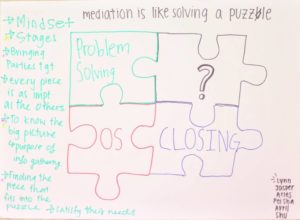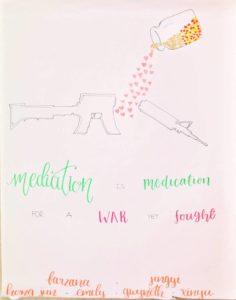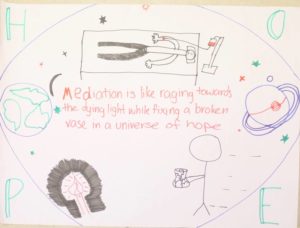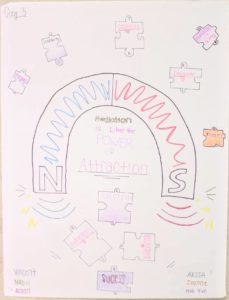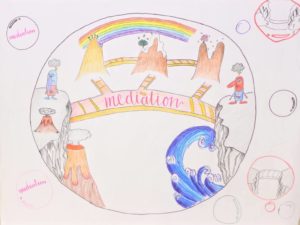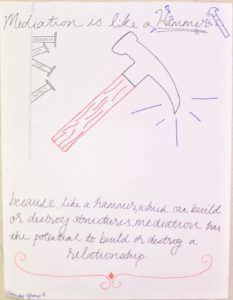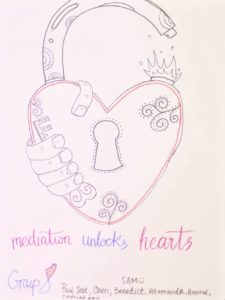I have in previous entries (July 2012, July 2013, November 2015 and August 2016) written about a peer mediation initiative called the Peacemakers Conference. The purpose of the Peacemakers Conference is to teach 13-16 year olds how to resolve conflicts amicably in a workshop cum competition format. This year’s Peacemakers Conference was held from 19 to 21 June 2017.
As in previous years, we asked students from different schools to work together to create a visual metaphor for mediation. This started in 2015 and has become a regular feature in the Peacemakers Conference.
This year, the students came up with 8 visual metaphors which I would like to share with readers in this entry. For each of these, an image of the metaphor is shared along with a description of the metaphor. Readers can also watch these students present their metaphors at the Peacemakers Facebook page.
I would like to acknowledge the efforts of Ms. Jennifer LIM Wei Zhen for capturing the description of each of the metaphors that appear below.
1. Mediation is like a lighthouse
Mediation is like a lighthouse, that provides illumination in the dark night. It guides ships safely to shore by providing light that penetrates the dark. Similarly, mediation guides conflicting parties to an agreement. It provides the signal of hope to their final destination: the shore that promises safety.
Mediation guides parties in conflict to get over their sea of difference and anger, to reach the place of safety: the shore where family is: bringing conflicted parties home with the bright light of mediation – because they care and hope is rekindled.
2. Mediation is like solving a puzzle
Mediation is like solving a puzzle as to solve the conflict, you need a big picture, just like referring to the picture on the box of a puzzle to solve it. Mediators need to gather and piece the different puzzles to solve the problem. Mediators find the piece that fits into the puzzle, and satisfies both parties’ needs.
Although each puzzle piece is different, they are brought together in trying to solve the puzzle. This parallels how in mediation, parties have different mindsets, but the mediator brings them together to resolve the situation.
Every puzzle piece is important, just as how all 4 steps in the process of mediation are important: without each of them, the mediation would be a failure.
The process of solving a puzzle highlights the traits a mediator should have: patience and perseverance. Like solving a puzzle, mediation may take hours or days to finish. Mediation takes quite long as parties cannot easily understand each other or find it difficult to come to a common ground. If a mediator rushes to conclude a mediation, the outcome might not be what the parties actually want. It requires persevering through a lot of trial and error. If the mediator gives up, the parties have no one left to help them resolve their conflict: the mediator is like a light for the parties.
3. Mediation is medication for a war yet fought
Mediation is like medication as it mends the wound in the parties’ hearts, and allows them to better understand each other.
Medication:
– The bottle of medication contains pills that are initially shaped as bullets. This parallels how initially, we only see the surface or the position of the parties. The words the parties say to each other in furthering their position may come out as sharp or hurtful – like bullets.
– After mediation, the parties understand each other better, so the bullets become heart-shaped: meaning the conflict can be resolved amicably.
A War yet fought:
– This is represented by the broken gun: which symbolizes attacks that are broken and conflicts that are being resolved.
– This parallels how many problems can be solved with mediation before they escalate into a “war” (such as a court case).
4. Mediation is like raging towards the dying light while fixing a broken vase in a universe of hope
This metaphor can be broken down into 3 parts.
– “Mediation is like raging towards the dying light”: this is depicted by the person in bed at the top of the picture. He is about to die, and is fighting against his own fate. Raging means to fight, and this quote means to fight against the dying light. Similarly, mediation is going against their internal conflict, going against the fate of the broken relationship, and hoping against hope, to get something out of it, to patch things up within themselves.
– “While fixing a broken vase”: the vase represents the communication and understanding between the 2 parties. While mediation fixes the broken vase, the vase will never look the same. Nonetheless, something new is still rebuilt. Even if the relationship is not as perfect as before, mediation still helps the two parties understand each other.
– “In a universe of hope”: the whole universe is something we have never seen before, but we know exists. Mediation helps people find that hope that people want, even if we can’t see it yet.
The process of mediation is as difficult as raging, but it allows understanding between parties by facilitating communication between them.
5. Mediation is like the Power of Attraction
The mediator is like a magnet, and the puzzle pieces are the elements of mediation. The mediator will ask the right questions to let the parties share their interests. The mediator will use their power to attract the right pieces for the parties to form a picture and common understanding of each other, to facilitate resolving the matter.
6. Mediation is like a Bridge
Mediation is like a bridge between two cliffs that are initially apart. Not being able to resolve a conflict hurts like a volcano and tsunami (depicted at the bottom of each cliff). This creates the sea of grief, emotions, and sorrow in between them.
Mediation lay and rebuilds a foundation between the parties with the strong sturdy bridge. It is not biased, but a platform to lead to each other, at their own pace to find their own hope and universe. It allows the parties to get out from the thunderstorm they are under and share the beautiful scene of the rainbow after the storm together, and create new beautiful memories. It’s no longer about victory or defeat, but creating a future together for both parties to enjoy.
Just as how mediation is a voluntary process, this bridge only works if both parties are willing to take a step forward, to take down their walls and build the bridge. Mediation is a bridge where parties stop talking about each other, but talk to each other. The parties are also contained in a bubble, in their own universe. This represents the confidentiality of mediation: no one knows about them – this bridge and universe is only for them, and significant to them only.
7. Mediation is like a Hammer
Like a hammer, mediation has the capacity to destroy or build structures (relationships). Nails can cause wounds, but they can also hold things in place. Thus, the nails are labelled “love”, “friendship”, “family”, “trust”. As the students wittily added: “Nails also mean if you did it [mediation] well, you NAILED it!” (sic).
8. Mediation Unlocks Hearts
Mediation unlocks hearts because when parties go through the mediation, they let down their ego and open up to each other. A hand is depicted as being wrapped around the padlock, as it is the mediator’s hand and touch that helps unlock the hearts. Although what is depicted is a single heart shape, this is because biologically speaking, the shape of a real human heart technically only comprises half a heart-shape. Thus, what is depicted is a single heart made of two human biological hearts: joined as one through mediation.
That brings us to the end of another installment of visual metaphors for mediation! I hope readers found some of these as inspiring as we did!
________________________
To make sure you do not miss out on regular updates from the Kluwer Mediation Blog, please subscribe here.




